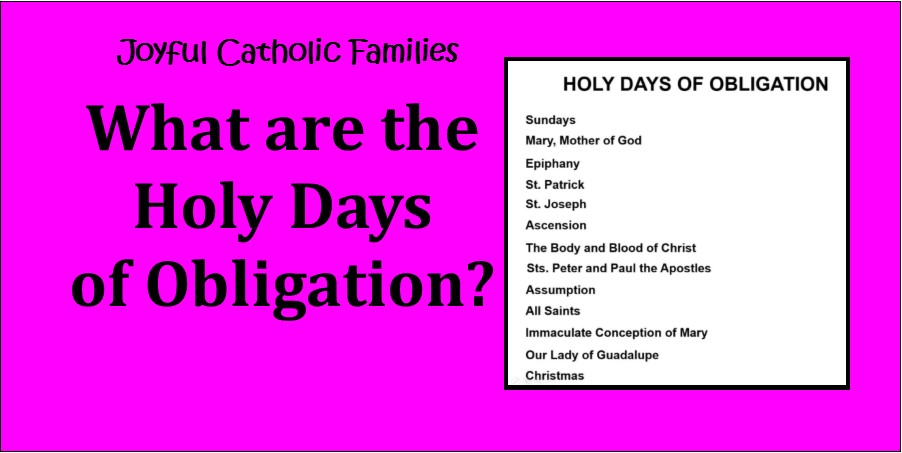
The Holy Days of Obligation are confusing. Some years we celebrate a Holy Day. Some years we don’t. Neighboring dioceses may celebrate the Ascension on different days. And countries have different Holy Days of Obligation.
This activity is a way to begin the discussion about the Holy Days of Obligation in the United States.
PDF for Holy Days of Obligation
- There are 10 feasts listed as Holy Days of Obligation in the Code of Canon Law.
- On the worksheet there are 12 days listed. Which two do you think are not Holy Days of Obligation mentioned in the Code of Canon Law? (St Patrick and Our Lady of Guadalupe)
- With a pen, draw a line through those two.
- These are the ten Holy Days (plus all Sundays) that are celebrated in Vatican City.

- Each country’s bishops decide (with the approval of the Apostolic See) which of these Holy Days of Obligation are celebrated in that country and which ones the obligation is transferred to a Sunday.
- Now look at the remaining 10 days. Decide what 8 are Holy Days of Obligation for the United States (this list includes those Holy Days of Obligation that have been permanently moved to a Sunday). Put an X in front of those 8. (If you don’t know which ones, guess!)
Note: All Sundays are Holy Days of Obligation so “Sundays” is already marked.

Using a yellow marker, “highlight” the 8 Holy Days of Obligation that the United States celebrates (including those that are permanently moved to a Sunday).
- Mary, Mother of God
- Epiphany
- Ascension
- The Body and Blood of Christ
- Assumption of Mary
- All Saints
- Immaculate Conception of Mary
- Christmas

Of these 8 days, most of the United States celebrates 3 of them on a Sunday. Which 3? (put a star after these)
- Epiphany
- Ascension
- The Body and Blood of Christ

Draw a line to the date (in the top box) that we celebrate each of these.
- Epiphany (permanently on the first Sunday after January 1)
- Ascension (celebrated on different days depending on where you live. Some celebrate it on its traditional date — Thursday of the sixth week of Easter. Most in the United States celebrate it on the seventh Sunday of Easter.)
- The Body and Blood of Christ (permanently on the second Sunday after Pentecost)

There are 5 remaining Holy Days of Obligation that you highlighted. These have a specific date (not a Sunday) that we celebrate them. Draw a line to the date in the lower box.)
- Mary, Mother of God (always celebrated on January 1, but if it is on a Saturday or a Monday there is no obligation to go to Mass)
- Assumption of Mary (always celebrated August 15, but if it is on a Saturday or a Monday there is no obligation to go to Mass)
- All Saints (always celebrated November 1, but if it is on a Saturday or a Monday there is no obligation to go to Mass)
- Immaculate Conception of Mary (always a day of obligation, except when December 8th falls on Sunday — then the Immaculate Conception is celebrated on December 9 and is not a day of obligation. Sundays of Advent take precedence over the Solemnity of the Immaculate Conception.)
- Christmas (always celebrated December 25 and always an obligation to go to Mass)

There can be added confusion Holy Days of Obligation because different countries have different Holy Days of Obligation. Mexico has 3 Holy Days of Obligation (not transferred to a Sunday) (underline those with red marker)
- Mary, Mother of God (January 1)
- Feast of Our Lady of Guadalupe (December 12)
- Christmas (December 25)

As you can see, the bishops can also add Holy Days of Obligation like Mexico did with Our Lady of Guadalupe.
What country do you think adds St. Patrick’s feast day? (Ireland)
For more information about Holy Days of Obligation, go to:
Check out these other activities on the liturgical year:


Leave a Reply